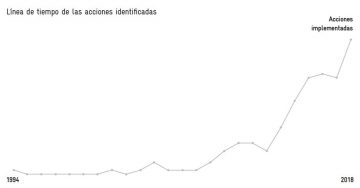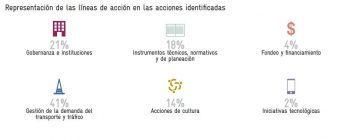This year, on World Cities Day, commemorated every October 31, the Ministry of Agrarian, Territorial and Urban Development and the German Cooperation for Sustainable Development (GIZ) presented the study Cities for mobility: best practices in Mexico, available on the web pages of SEDATU and IKI Alliance.
This compilation and analysis of best practices in the territory of the country, aims to share success stories of public policies, projects and initiatives to promote walking, cycling and public transportation, and, in turn, discourage the use of motorized private vehicles. The study is expected to serve as a guide for replicating the best documented mobility practices, considering the context, qualities and adaptation in other locations.
The great interest in promoting better mobility practices is reflected in the 182 identified actions that have been implemented by Mexican governments at their different levels during the last 25 years. It is important to note that a boom is identified during the last six years, where the largest number of actions are concentrated.

43% of these actions belong to the line of action on public policy, while 57% to projects and initiatives. Finally, it was identified that 57% of the practices implemented during the analyzed period are municipal, 32% statewide, 7% metropolitan and 4% national and that the central region, formed by the states of Guerrero, Hidalgo, State of Mexico, Morelos, Puebla, Tlaxcala and Mexico City, has the highest number of practices implemented. This is due to the fact that local governments execute more projects, while the federal government, in addition to granting financial resources, serves as a driving force.

It was identified that Traffic and transport management is the category with more actions (41%). This shows that Mexican governments have focused on the implementation of infrastructure, equipment and transportation systems. In comparison with the few actions on Funding and financing (4%), which suggests the urgency of creating a specific fund or financing mechanism for the mobility of cities and metropolitan areas of the country.
As proof of this, among the actions of Traffic and transport management with considerable participation, are the mass public transportation systems which have mostly been funded by the Federal Mass Transportation Support Program. This demonstrates that the establishment of specific resources would allow the concretization of other modes of transportation such as pedestrian and cycling mobility, as well as measures for collective public transportation, urban merchandise management and to discourage excessive use of motorized private vehicles.

The categories of best practices were outlined in response to the main barriers that inhibit the development of efficient and environmentally friendly modes of transportation: lack of specialized institutions; prioritization of resources distribution; generation of regulatory, technical and planning instruments; and the periodic evaluation of the projects.
It is certain that the governments of Mexican cities have implemented numerous actions to boost mobility on foot, by bicycle and in public transportation. However, few cities have moved from promoting it to establishing a public policy. This is reflected when the actions implemented are based on specialized instruments and areas. Those cities that formalized the public mobility policy have implemented more and better actions. Such is the case of Mexico City, Guadalajara and Puebla. The participation of Zapopan and Tlaquepaque should also be highlighted, as they are replicating Guadalajara’s best practices, reinforced with specialized institutions and other metropolitan governance mechanisms such as the metropolitan mobility board.
In summary, we suggest 6 basic needs for Mexican cities to achieve more and better projects and actions for sustainable mobility:
- Greater coordination between the three levels of government in normative and planning instruments to link them between the granting and the application of resources to projects that are based on solid planning instruments.
- Formalization of specialized areas in all cities, metropolitan areas and states of the country, to achieve comprehensive public policies and greater scope for the implementation of actions for sustainable mobility (only 1% of the municipalities and 28% of the states have a specialized mobility area).
- Creation of a specific financing fund or mechanism for mobility of the cities and metropolitan areas of the country, as well as the adjustment of the rules of operation of the existing funds, which, in turn, continue to finance infrastructure oriented to private motor vehicles, but not to people or to combat the climate emergency.
- Take the opportunity of practices that have been less replicated: urban merchandise management, green infrastructure implementation, culture actions and technological innovation. (See also the excursus at the end of this article).
- Improve the documentation of the actions implemented by governments: It was identified that most of the information is not public, thus it is even more difficult to replicate best practices, and opportunities for obtaining national and international funding and financing, related to the climatic emergency and other sectors are wasted.
- Increase access to training and exchange offers on good practices in different areas, among them: street design, cycling mobility, planning of integrated transportation systems (through cooperation with existing operators), demand management (i.e. congestion and pollution charging systems).
Although the indicators and the evaluation itself are ambitious, the results reflect that Mexico has a great challenge to implement comprehensive projects. If there really is an interest to promote a public mobility policy that encourages walking, bicycle use and public transportation, it is necessary to develop projects in coordination with other areas so that economic, environmental and social benefits are considered from the planning and design phase onwards.
The progress that Mexico has made in the matter of mobility during the last 25 years is decisive. However, it is necessary to solve the barriers identified and learn to replicate the best practices so that there are more Cities for mobility. Fortunately, more local governments and sectors are beginning to promote innovative public policies, considering the relationship between urban structure, socio-economic conditions and travel decisions.
Practices that are (almost) not observed in Mexico
The practices that have been less replicated are those related to urban merchandise management, green infrastructure implementation, cultural actions and technological innovation. This represents an opportunity to generate new initiatives or improve existing ones, which are scarce.
Example 1: While transport network companies like Uber, Didi, Cabify, etc., put users in the middle of their interest, there is little practical information about public transportation services. Citymapper and moovit are accessible private and social initiatives in some cities, but governments and operators have shown little initiative to offer the necessary information at stations and stops, websites and even applications so that people can plan their trips easily and in real time.
Example 2: Intelligent traffic light systems cannot be identified in public transportation corridors. In other countries they are popular and successful, as they allow public transportation to be prioritized before private vehicles at crossings, and to reduce travel times for users and costs for companies that operate the service.
Example 3: The “Green Infrastructure” allows the realization of several benefits such as the combat of heat islands, less impact of floods, providing more shade and better air quality, and in turn, less construction and maintenance costs. Although green infrastructure elements were applied in some street and public space projects in cities such as Hermosillo and Mexico City, it is not yet systematically implemented in these cities or in the rest of the country.
